· By Brad Fulton
HISTORY OF THE DAN & DAVE PLAYING CARD COMPANY
HISTORY OF THE D&D PLAYING CARD COMPANY
Who’d have thought a twin brother duo from small-town Sonora, California would create an entire industry?
Dan & Dave Buck (b. 1984) grew up practicing magic after finding an abandoned magic kit in their shed—sounds like a fairy tale but it’s true. This discovery would lead to the two filling their time learning everything about the art of magic. When they had exhausted the well, they decided to expand on the concept of “card flourishing” and Cardistry was born. The history of Cardistry is well documented, but their contributions to the design and business of playing cards are less discussed. Let me fill in the blanks here.
Playing cards as a whole remained little changed since the pioneering days of design that commenced in the early 20th Century. Juggernauts such as Andrew Dougherty created an industry that elevated the simple playing card to that of art.
When we think of a playing card, we most likely imagine Bicycle or Tally-Ho—both brands were purchased and consolidated by the US Playing Card Co (USPCC) and remain viable to this day. But how did this new world of customization begin? Although many have added to the concept of re-imagining the standard deck of cards, few have transformed an entire industry in the modern era as Dan & Dave Buck.
Unsatisfied with the design options available to them, the twin brothers began crafting a concept for their very own pack of cards. Numerous ideas were considered but a chance meeting with Brad Fulton would change the modern history of cards forever.
Dan & Dave had left their small town in Northern California with lofty dreams of making it big as directors of their own feature films. They packed their belongings into a Volkswagen Jetta and scraped enough cash together to rent an apartment in Costa Mesa, CA—a suburb in Orange County roughly 39 miles south of Los Angeles. Their goal was to excel at Orange Coast Community College (a major transfer hub to USC) and gain acceptance to the storied USC Film School. To make ends meet, Dave Buck gained employment at the then-new Apple Store in South Coast Plaza (store number 04). Dan would take odd jobs while learning how to edit and produce their own Cardistry Tutorial Videos.
Dave Buck befriended a young Brad Fulton—himself a recent graduate of the Film Program at USC working at Apple to fund his own dreams of writing and producing his films. Eager to learn what it took to get into the school—and more importantly—how films were made, Dave began spending a lot of time with Brad in hopes of learning the craft of filmmaking. Brad offered Dave a chance to learn how cameras worked while photographing the new art form of Cardistry. Dave was enthusiastic and agreed to meet on early mornings to take photos—and take notes—in a small high school pumpkin patch in Westminster, CA. This was the first known photographic capture of Modern Cardistry. The two would continue their explorations of merging filmic arts and playing cards in obscurity for years.
At this time Brad was attending Art Center in Pasadena to further explore his fascination with type and graphic design. Sharing these interests, The Buck Twins and Fulton would often have a coffee and discuss opening their own design firm specializing in business cards for the various industries of Southern California. Dan & Dave often elevated Fulton’s ideas to a new level—of concept and production cost. On one occasion Dave outlined an idea to print a business card in a three dimensional cube shape but when the group obtained the potential cost of each card it became unfeasible for most clients.
Dan & Dave continued to scrape by financially while never losing sight of their dreams. The two continued advancing their skills with cards and cameras—producing the groundbreaking “The System” out of their small apartment. The System broke the boundaries of what could be done with a deck of cards and spawned a cottage industry of Instructional Cardistry DVDs. With the cash made from this venture the two began dreaming of making their own cards to use in their videos.
Dan & Dave often accompanied Brad on his daily visit to Mitsuwa Japanese Market to get his dose of oolong tea. On one now historic trip, The Twins expressed their frustration with their ideas for the aforementioned D&D Deck. Brad quickly quipped “Just make one black and one white and call one SMOKE & the other MIRRORS. D&D looked at each other as if they cleared the hurdle and the trio then had their tea while discussing the next steps.
“You mean you can actually design your own deck of cards?” said Fulton. The idea bordered on Sci-Fi. Playing cards are so much a part of the American Lexicon that to create your own seemed far fetched—but the Wonder Twins of Sonora had already done their homework.
“Yeah, we can get them made by the US Playing Card Co just like Bicycle Decks.” said Dave.
Now, Brad had often accompanied The Twins to Costco in Fountain Valley, CA where they’d purchase brick boxes of Bicycles, and often noticed the attention to detail they embodied. They would often open two bricks in store—one red and one blue—swapping six of each to give themselves a “mixed brick.” This was the first time Brad had considered the design and color choices of playing cards.
Months passed and the three continued production on Brad’s short films—often starring Dan Phillips. One day another Mitsuwa Meetup saw The Twins bring a box under their arm.
“Here you go Brad”…
D&D gifted Brad a brick of the aforementioned deck, one black, one white—SMOKE & MIRRORS. The feeling was astonishing—for these two brothers to dream and then hold their own creation in this era was a feeling unimaginable to modern card aficionados in the current era of Kickstarter and presales.
Contrary to the current opinion of Smoke & Mirrors, the original was not a runaway success. The cards were sold on The Twins Website and shipped peicemeal out of their apartment before being transferred to a distribution center where each order incurred a “pull fee” that often led D&D to losing money. In hindsight its hard to imagine that this was essentially the beginning of the modern playing card industry.
As years went by, the Smoke & Mirrors Line gained popularity — mostly due to the continued release of Dan & Dave’s amazing Cardistry videos. Without the jaw dropping displays created and performed by the twins its hard to imagine their playing card line gaining as much exposure.
The dream of attending USC Film School ended when The Twins were denied entry due to an error on their admission application. They had achieved a perfect GPA at Orange Coast College and had numerous lofty letters of recommendation lined up for SC, but it was not meant to be—and arguable was the way things were supposed to turn out.
Cathy Daly, longtime business manager and liaison to David Copperfield was close to D&D, and made them an offer they couldn’t refuse. If they packed their bags and headed four hours east to Vegas she would give them free room and board in exchange for them caretaking her townhome while she worked internationally. Without the burden of a 9-5, The Twins dedicated upwards of 16 hours a day to produce their magnum opus, THE TRILOGY. A groundbreaking three-disc set of Cardistry Videos would be written, directed and produced by the twins and gain international acclaim. The success of The Trilogy in large part gave The Buck Twins the ability to produce more of their own playing cards and even branch out to apparel design.
After returning to Southern California, The Twins decided to set up shop just blocks away from the famed Magic Castle. They set up an office to continue their design and marketing of the playing card industry. Smoke & Mirrors saw a few sequels which grew the brand beyond any previous expectations. In 2010 their close collaborator and friend Brad Fulton had an accident which left him dead for three minutes. Following the mishap Fulton had a vision to create a deck of cards from a place he saw in his dreams—Fulton’s Clip Joint. It was a place that had the aura of his beloved grandfather Sam Fulton.
The pitch for Clip Joint would take place at Hamamori Sushi in the same mall Brad had worked with Dave so many years earlier, South Coast Plaza. This time it was Dan Buck and Brad engaged in discussion about the potential of The Clip Joint in terms of playing cards. Dan listened carefully and concluded that the project was too good to turn down. This would begin the new chapter for both of them—Fulton as playing card designer and Dan & Dave as producers—a role they cherish today.
The next decade would see Brad Fulton formally join D&D at their burgeoning playing card empire as creative director—often seen walking down Hollywood Blvd with the twins dreaming as they always had. The only thing that changed was the ability to now actually produce the things they had previously dreamed of. This time is often refereed to as the “Golden Era” of modern playing cards—a renaissance of sorts kicked off by three unlikely partners in crime.
The story doesn’t end, instead it grows. Today The Twins and Fulton continue to create playing cards together. Dan & Dave since founded Art of Play which is an online wonder emporium-sourcing curiosities and puzzles from around the globe as well as producing their own.

